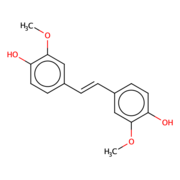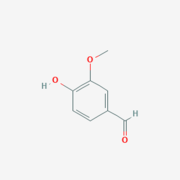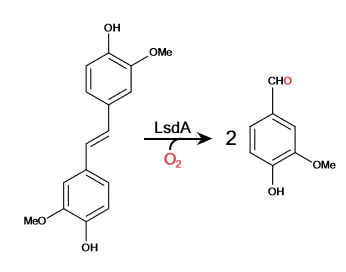Sandbox reserved 1560
From Proteopedia
(Difference between revisions)
| Line 10: | Line 10: | ||
Lignostilbene-α,β-dioxygenase A (LsdA) is an enzyme found in the bacteria ''Sphingomonas paucimbilis''.<ref>PMID:31292192</ref> It is used to catalyze the substrate, lignostilbene, into two vanillin molecules. Vanillin is a member of the benzaldehydes class and plays a role in the plant metabolite<ref>https://pubchem.ncbi.nlm.nih.gov/compound/Vanillin</ref>. Lignin is found in the plant cell walls, lignocellulose, and it gives the plant its rigid structure. The depolymerization of the lignin can allow for better use of the plants resources as a source of biofuel. | Lignostilbene-α,β-dioxygenase A (LsdA) is an enzyme found in the bacteria ''Sphingomonas paucimbilis''.<ref>PMID:31292192</ref> It is used to catalyze the substrate, lignostilbene, into two vanillin molecules. Vanillin is a member of the benzaldehydes class and plays a role in the plant metabolite<ref>https://pubchem.ncbi.nlm.nih.gov/compound/Vanillin</ref>. Lignin is found in the plant cell walls, lignocellulose, and it gives the plant its rigid structure. The depolymerization of the lignin can allow for better use of the plants resources as a source of biofuel. | ||
| - | + | ===''Lignostilbene''=== | |
| + | [[Image:Lignostilbene svf.png | thumb]] The lignostilbene is a compound found in cellulose | ||
| + | === ''Vanillin'' === | ||
| + | [[Image:Vanillin.png | thumb]] The lignostilbene is a compound found in cellulose | ||
| + | === Cleavage of Lignostilbene === | ||
| + | [[Image:Lignostilbene cleaving.png]] | ||
== Broader Implications == | == Broader Implications == | ||
Lignocellulosic biomasses have been used for biofuels, mainly bio-ethanol. The abundant avaiability of the raw material make the use of biomasses ideal. With the rise of carbon emission, biomasses can be used to substitue the need for carbon based fuel, as long as, the biomass is carbon neutral.<ref>Carroll, Andrew; Somerville, Chris (June 2009). "Cellulosic Biofuels". Annual Review of Plant Biology. 60 (1): 165–182. doi:10.1146/annurev.arplant.043008.092125.<ref/> Lignostilbene is the second most abundant raw material. | Lignocellulosic biomasses have been used for biofuels, mainly bio-ethanol. The abundant avaiability of the raw material make the use of biomasses ideal. With the rise of carbon emission, biomasses can be used to substitue the need for carbon based fuel, as long as, the biomass is carbon neutral.<ref>Carroll, Andrew; Somerville, Chris (June 2009). "Cellulosic Biofuels". Annual Review of Plant Biology. 60 (1): 165–182. doi:10.1146/annurev.arplant.043008.092125.<ref/> Lignostilbene is the second most abundant raw material. | ||
| - | == Energy Transformation == | ||
| - | When Phe 59 is substituted with His and Tyr 101 is substituted with Phe, the k (app/cat) decreases in activity by 15-10 folds. The Lys 134 substitution of Met inhibits the enzyme activity. Phenylazophenol inhibits the LsdA-catalyzed cleavage of lignostilbene with a competitive and uncompetitive inhibition. | ||
| - | |||
| - | == Structural highlights == | ||
| - | <scene name='82/823083/6ojttriad/1'>catalytic triad</scene> and <scene name='82/823083/Nsl_ligand/1'>ligand</scene>. | ||
Revision as of 16:38, 2 December 2019
| This Sandbox is Reserved from Aug 26 through Dec 12, 2019 for use in the course CHEM 351 Biochemistry taught by Bonnie_Hall at the Grand View University, Des Moines, USA. This reservation includes Sandbox Reserved 1556 through Sandbox Reserved 1575. |
To get started:
More help: Help:Editing |
Lignostilbene-α,β-dioxygenase A (LsdA) Catalyzation
| |||||||||||
References
- ↑ Kuatsjah E, Verstraete MM, Kobylarz MJ, Liu AKN, Murphy MEP, Eltis LD. Identification of functionally important residues and structural features in a bacterial lignostilbene dioxygenase. J Biol Chem. 2019 Jul 10. pii: RA119.009428. doi: 10.1074/jbc.RA119.009428. PMID:31292192 doi:http://dx.doi.org/10.1074/jbc.RA119.009428
- ↑ https://pubchem.ncbi.nlm.nih.gov/compound/Vanillin
- ↑ Carroll, Andrew; Somerville, Chris (June 2009). "Cellulosic Biofuels". Annual Review of Plant Biology. 60 (1): 165–182. doi:10.1146/annurev.arplant.043008.092125.<ref></ref> Lignostilbene is the second most abundant raw material.



